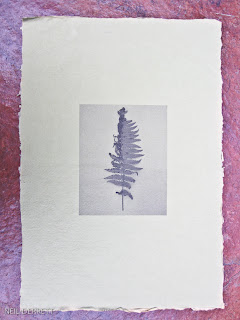Part 3 of the Salt Printing Experiment is the fun bit. After preparing the paper and light sensitve solution you can comence the contact printing.
The first part of the process is to coat the sized paper with the light sensitive solution. This is achieved by clamping the paper by one edge to prevent movement. Place the glass rod spreader at the clamped edge. With a syringe take approx 5m of the silver nitrate solution and run a thin bead along the spreading rod. Run the rod to the other edge of the paper, at the end lift and then place back on the paper and run back towards the clamped end. Repeat this twice. On the last run lift the rod and wipe clean. Allow the paper to dry fully. This stage can be sped up by the use of a hair dryer. When completly dry select a suitable negative and place on top of the paper emulsion side down and mount in a contact printing frame. Place in direct sunlight for 10 to 15 mins.
The last stage is to develop the paper. This is quite a long process compared to modern silver based processes. 5 trays are required:
Tray 1 3% Salt bath: 30g kosher salt, 1 litre distilled water and 10g citric acid - 5 minutes
Tray 2 Wash bath: clear water - 15 minutes -
Tray 3 10% Sodium Thiosulfate fixing bath: 100g sodium thiosulfate, 1 litre distilled water and 2g sodium bicarbonate - 30 to 60 seconds
Tray 4: Hypo Clearing Bath: 10g sodium sulfite and 1 litre distilled water - 3 minutes
Tray 5: Final Wash - 20 minutes






















